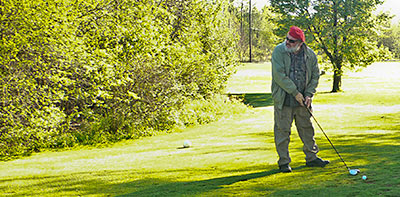Golf: Getting Started

Get in Shape to Play Golf
Many golfers, especially those over 50, experience a variety of playing-related injuries, typically affecting their hips, back, shoulders, elbows and neck. One reason for the numerous golf injuries is the explosive, body-twisting action required to swing the club for a drive.
Another reason for injuries is the less than ideal level of fitness, strength and conditioning of most recreational golfers. In fact, many golfers believe that strength training, especially, builds large, tight muscles that might inhibit their game. Older golfers often believe that strength building will exacerbate lower back pain and arthritic discomfort.
More specific research has proved this to be untrue. It is generally accepted, for instance that strength training can reduce body weight and resting blood pressure, and alleviate lower-back and arthritic pain. Perhaps finding the time to make the investment in improved strength and conditioning is the real problem golfers' face.
Based on findings, golfers' concerns that strength training will add body weight, raise resting blood pressure, aggravate arthritis, cause lower back problems, reduce flexibility, impair body coordination and decrease swinging speed seem unfounded. In fact, research clearly shows that a simple program of strength and stretching exercises is most desirable for improving physical fitness, reducing injury risk and enhancing playing ability in senior golfers.
Becoming a new golfer takes dedication, practice and lots of patience.
It is like getting involved with anything for the first time - always begin by asking certified professionals the right questions.
You will want to take a golf lesson by a certified professional, who you feel comfortable with.
After the lesson, if this is something that you want to invest your time in seek out some clubs, you don't have to get the most expensive clubs right away.
You can go to places like Play it Again Sports, Dicks Sporting Goods, MC Sports, etc...
Practice…Once you have taken a golf lesson, you need to spend time on the driving range practicing what you have learned.
Depending on where in the country you live, say if you live in Michigan, you might want to begin the learning process in the spring. That way you have a good three months that you have ideal weather to be outside practicing.
I would recommend that you don't go right to the golf course; take lessons to guide you in every aspect of the game, maybe even take a playing lesson.
Golf lessons are beneficial to you…They will help to develop your swing and your game the right way.
The most important part and what I think is the best…Have fun, don't let learning something new stress you out.
If you can remember to stay relaxed, you will enjoy getting bitten by the golf bug.

